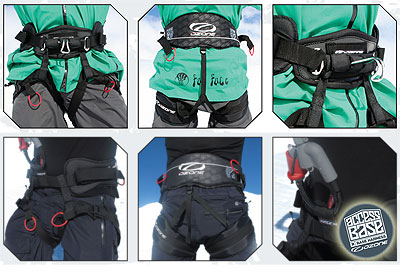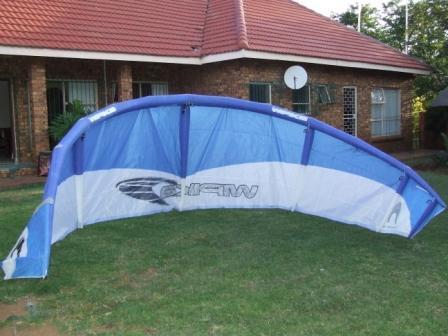Source(google.com.pk)
Kite Surfing Harness Biography
'Kite Surfing' Helps Harness Wind Power
TechNewsDaily Staff
November 06 2012 04:44 PM ET
Stunt Kite Surfing
[Pin It] A kite designed to harness wind power makes its maiden voyage during a test by the German startup NTS GmbH.
CREDIT: Fraunhofer IPA
View full size image
Wind power could work almost anywhere if people turned to high-flying kites rather than relying on just wind turbines. The latest startup to run with that idea wants to harness high-altitude winds through the use of "kite surfing" technology.
Kite surfers typically attach themselves to stunt kites so that they can "leap" high into the air. Berlin-based startup NTS GmbH wants to use similar kites to drive a generator that can convert the kinetic energy from the kites' motions into electricity — a method that can make even lowland sites that have very little wind at ground level suitable for harnessing wind power.
"The energy yield of a kite far exceeds that of a wind turbine, whose rotor tips turn at a maximum height of 200 meters (656 feet)," said Joachim Montnacher, an engineer at the Fraunhofer Institute for Manufacturing Engineering and Automation IPA in Germany. "Doubling the wind speed results in eight times the energy."
Remote-controlled kites would have an advantage over wind turbines because they can fly at much higher altitudes where wind speeds increase considerably and stay consistently strong. Such kites also cost much less to build than wind turbine towers.
Montnacher and his colleagues envision the kites flying at altitudes of about 1,000 to 1,600 feet (300 to 500 meters) where they can catch strong winds. The swooping kites would have cables almost 2,300 feet (700 m) long that allow them to pull vehicles around a circuit on rails, so that generators could turn the vehicles' kinetic energy into electricity.
The startup and Fraunhofer researchers have already conducted a first test with a kite flying along a straight track 1,300 feet (400 m) long. As a next step, they hope to make the test track into a loop and hand over human remote control of the kites to automatic computer control.
Other companies such as California's Makani Power have experimented with flying wind turbines that resemble a cross between model airplanes and kites. Italy's KiteGen Research has also experimented with kites flying a mile (5,280 feet) above the Earth to generate wind power. A new startup hopes to give brick-and-mortar stores some of the same traffic statistics that online shops already have, MIT Technology Review reported. The new system, called Euclid, records anybody carrying a smartphone or tablet by recognizing the signal such devices give off when they recognize the store's Wi-Fi.
Euclid's tracking gives storeowners data such as how long people linger in the store, how many people visit the store repeatedly and what percentage of passersby come in. Of course, websites already have such numbers — and more — gathered from online cookies. Physical stores' visitor data are often much less sophisticated, however.
"Most stores are still using clipboards and clickers," Scott Crosby, Euclid's chief operating officer, told Technology Review. Crosby previously worked on creating Google Analytics, a service that gives website owners detailed visitor statistics.
Crosby gave some examples of how Euclid clients are using their newfound data. One client, which Crosby didn't name, found that mailing out catalogues doesn't make a dent in store visits. (We can't wait until more stores realize this.)
Euclid will have to compete with other store-tracking technology, including store loyalty apps, video monitoring and pressure mats and infrared sensors at the door.
Technology Review has more info on how many companies use Euclid's software, plus how to opt out of Euclid's tracking.
Facebook New Faces
[Pin It]
CREDIT: Laptopmag.com
View full size image
Today, Facebook announced it has indexed more than a trillion connections between users to create its new Graph Search feature. The social network hopes to make it simple and easy to find specific answers to easy queries such as “who of my friends lives in San Francisco?” and complex queries such as “restaurants in New York liked by chefs.”
CEO Mark Zuckerberg was quick to point out how different Graph Search is from a Web Search, because Web only returns links and Graph Search returns answers. However, if you can’t find what you want in the index created by the social network, you will be able to perform a Bing Web search from within the network.
For the first beta version of Graph Search, Facebook focused on people, photos, places and interests. For starters the service will only be available as a limited beta at Facebook.com/graphsearch. Mark Zuckerberg says there’s plenty more to index, but with 240 billion photos and more than a billion users, this is probably plenty to get people attached to searching their friends. In the future, Zuckerberg plans to index mobile, languages (currently only English) and all posts that have been put up by users worldwide.
Forget Googling your friends: Now you can much more easily stalk people you know. But you can also find out about people not in your network. Searching “friends with friends who are single men,” for instance, will help you match-make for your friends. To lock yourself out of such searches, you’ll need to limit what fields in your profile that you fill out. The engine can only find those things you volunteer, such as alumni, location, origins, employer, etc.






















Kite Surfing Harness Biography
'Kite Surfing' Helps Harness Wind Power
TechNewsDaily Staff
November 06 2012 04:44 PM ET
Stunt Kite Surfing
[Pin It] A kite designed to harness wind power makes its maiden voyage during a test by the German startup NTS GmbH.
CREDIT: Fraunhofer IPA
View full size image
Wind power could work almost anywhere if people turned to high-flying kites rather than relying on just wind turbines. The latest startup to run with that idea wants to harness high-altitude winds through the use of "kite surfing" technology.
Kite surfers typically attach themselves to stunt kites so that they can "leap" high into the air. Berlin-based startup NTS GmbH wants to use similar kites to drive a generator that can convert the kinetic energy from the kites' motions into electricity — a method that can make even lowland sites that have very little wind at ground level suitable for harnessing wind power.
"The energy yield of a kite far exceeds that of a wind turbine, whose rotor tips turn at a maximum height of 200 meters (656 feet)," said Joachim Montnacher, an engineer at the Fraunhofer Institute for Manufacturing Engineering and Automation IPA in Germany. "Doubling the wind speed results in eight times the energy."
Remote-controlled kites would have an advantage over wind turbines because they can fly at much higher altitudes where wind speeds increase considerably and stay consistently strong. Such kites also cost much less to build than wind turbine towers.
Montnacher and his colleagues envision the kites flying at altitudes of about 1,000 to 1,600 feet (300 to 500 meters) where they can catch strong winds. The swooping kites would have cables almost 2,300 feet (700 m) long that allow them to pull vehicles around a circuit on rails, so that generators could turn the vehicles' kinetic energy into electricity.
The startup and Fraunhofer researchers have already conducted a first test with a kite flying along a straight track 1,300 feet (400 m) long. As a next step, they hope to make the test track into a loop and hand over human remote control of the kites to automatic computer control.
Other companies such as California's Makani Power have experimented with flying wind turbines that resemble a cross between model airplanes and kites. Italy's KiteGen Research has also experimented with kites flying a mile (5,280 feet) above the Earth to generate wind power. A new startup hopes to give brick-and-mortar stores some of the same traffic statistics that online shops already have, MIT Technology Review reported. The new system, called Euclid, records anybody carrying a smartphone or tablet by recognizing the signal such devices give off when they recognize the store's Wi-Fi.
Euclid's tracking gives storeowners data such as how long people linger in the store, how many people visit the store repeatedly and what percentage of passersby come in. Of course, websites already have such numbers — and more — gathered from online cookies. Physical stores' visitor data are often much less sophisticated, however.
"Most stores are still using clipboards and clickers," Scott Crosby, Euclid's chief operating officer, told Technology Review. Crosby previously worked on creating Google Analytics, a service that gives website owners detailed visitor statistics.
Crosby gave some examples of how Euclid clients are using their newfound data. One client, which Crosby didn't name, found that mailing out catalogues doesn't make a dent in store visits. (We can't wait until more stores realize this.)
Euclid will have to compete with other store-tracking technology, including store loyalty apps, video monitoring and pressure mats and infrared sensors at the door.
Technology Review has more info on how many companies use Euclid's software, plus how to opt out of Euclid's tracking.
Facebook New Faces
[Pin It]
CREDIT: Laptopmag.com
View full size image
Today, Facebook announced it has indexed more than a trillion connections between users to create its new Graph Search feature. The social network hopes to make it simple and easy to find specific answers to easy queries such as “who of my friends lives in San Francisco?” and complex queries such as “restaurants in New York liked by chefs.”
CEO Mark Zuckerberg was quick to point out how different Graph Search is from a Web Search, because Web only returns links and Graph Search returns answers. However, if you can’t find what you want in the index created by the social network, you will be able to perform a Bing Web search from within the network.
For the first beta version of Graph Search, Facebook focused on people, photos, places and interests. For starters the service will only be available as a limited beta at Facebook.com/graphsearch. Mark Zuckerberg says there’s plenty more to index, but with 240 billion photos and more than a billion users, this is probably plenty to get people attached to searching their friends. In the future, Zuckerberg plans to index mobile, languages (currently only English) and all posts that have been put up by users worldwide.
Forget Googling your friends: Now you can much more easily stalk people you know. But you can also find out about people not in your network. Searching “friends with friends who are single men,” for instance, will help you match-make for your friends. To lock yourself out of such searches, you’ll need to limit what fields in your profile that you fill out. The engine can only find those things you volunteer, such as alumni, location, origins, employer, etc.
Kite Surfing Harness

Kite Surfing Harness

Kite Surfing Harness

Kite Surfing Harness

Kite Surfing Harness

Kite Surfing Harness

Kite Surfing Harness

Kite Surfing Harness

Kite Surfing Harness

Kite Surfing Harness

Kite Surfing Harness

Kite Surfing Harness

Kite Surfing Harness

Kite Surfing Harness

Kite Surfing Harness

Kite Surfing Harness

Kite Surfing Harness

Kite Surfing Harness

Kite Surfing Harness

Kite Surfing Harness

Kite Surfing Harness

Kite Surfing Harness

Kite Surfing Harness
No comments:
Post a Comment